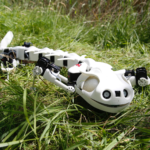Pleurobot: The Robo-Salamander
At the École Polytechnique Fédérale de Lausanne, engineers have designed a robot that mimics the motion of a salamander. The robot imitates the ambulation of the salamander with a unique vertebrate that allows the robot to slither in and out of the water. A salamander in nature can shift from a crawl to a walk to a swim by performing the same motion at different speeds. This appealed to the engineers because one doesn’t need to create different mechanisms to achieve different movements, but rather find the optimal mechanism that can perform several movements. The skeleton of the Pleurobot has only 11 spinal segments, down from the original 40 planned segments, which were not critical for the bot’s movement. The joints also have reduced freedom of movement. Auke Ijspeert, leader of the project, explains that understanding the neuro-prosthetics of the salamander is important for understanding the human spinal cord and brain interaction. “Being able to re-stimulate those circuits in humans in the long term is something very important,” he says, “and for that you need to understand how the spinal cord works.”
Learn about our two Decals!
 Click here to find out more about our Fall Bioinspired Design Decal and our Spring Bioinspired Design in Action Decal – ALL MAJORS are welcome.
Click here to find out more about our Fall Bioinspired Design Decal and our Spring Bioinspired Design in Action Decal – ALL MAJORS are welcome.Berkeley BioDesign Community
 Click here to learn about the BioD: Bio-Inspired Design @ Berkeley student organization or here to signup for more info.
Click here to learn about the BioD: Bio-Inspired Design @ Berkeley student organization or here to signup for more info.Search
Student Login




I imagine that the neurological circuits underlying these processes are governed by both 2d spacing maps with their brains as…
to reduce the impact of car accidents, it may be possible to study the force diverting physics of cockroaches to…
you see this type of head-bobbing stability in many avian creatures related to pigeons like chickens. the head ability to…
not like they taught horses how to run! this is an example of convergent evolution where both sea creatures and…
The brain functions in a similar way with neuronal connections. our brains are able to utilize the multiplicity of connections…